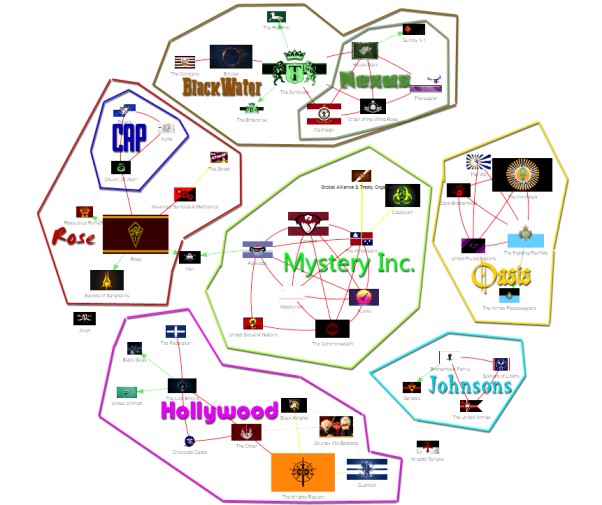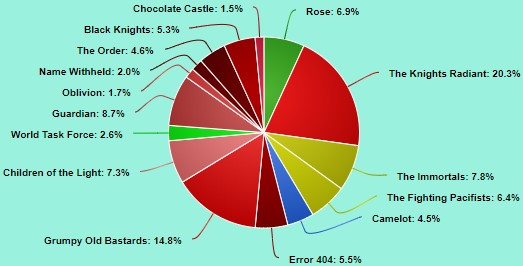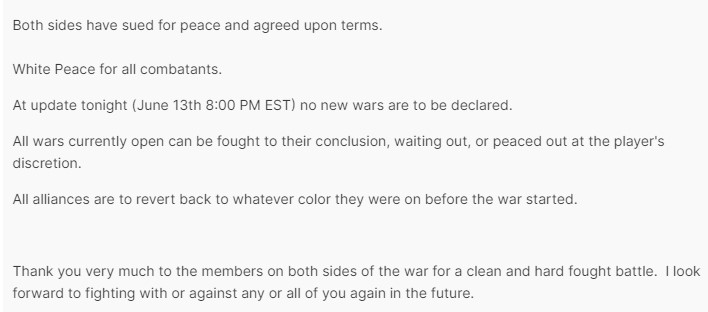Politics and War is a popular online browser game in which players create their own nations and work to win wars, add cities, and become a capable world leader in their own right. Players need to buy infrastructure for city improvement slots (which they use for hospitals, barracks, malls, and more), and as the cost to build infrastructure increases, players can invest in building more cities, which cannot be destroyed, whereas infrastructure can be.
Joining an alliance is a player’s best hope for long-term growth, as these large groups of players are able to help fund the growth of all members via grants, loans, and more. Additionally, without an alliance a player is likely to be raided for all the money they produce and have valuable infrastructure destroyed. With these alliances come wars, often times “Great Wars” between large coalitions of opposing alliances. These periodic global wars help keep the game from stagnating and players from growing bored.
The latest global war was named “Guns N Roses,” and was very important to the game’s history. Four spheres (groups of alliances allied to each other) were involved in the war: Hollywood, Rose, Oasis, and Mystery Incorporated. Hollywood formed when an old sphere, Quack, split into two parts. One part was composed of The Knights Radiant (TKR) and their allies, the other was composed of The Syndicate (t$) and their allies. The Knights Radiant and their allies merged with another old sphere, Hedge Money, to form Hollywood.

This new sphere attacked Rose Sphere (which is centered around Rose and their allies, and is very old) over a variety of things, including secret treaties in a previous war, Duck Hunt. Oasis (which was a splinter of an old sphere known as Swamp) and Mystery Inc (another ex-Swamp splinter) each in turn declared war on Hollywood.
The reason behind Oasis and Mystery Inc declaring war on Hollywood relates to the theory of “minispheres”, an idea that had been floated around quite a bit. The goal of minispheres is to have a lot of small spheres that can declare war on each other for short wars lasting only a few weeks at max and end with no nonaggression pact. The Knights Radiant and Hedge Money teaming up seemed like a middle finger to that ideal, which many alliances had been working towards, and so Oasis and Mystery Inc showed their displeasure with Hollywood’s formation by declaring war in support of Rose.

Guns N Roses lasted for exactly 21 days before both sides reached an agreement to white peace (a peace agreement where neither party surrenders nor claims victory). The war ended with over 1.2 trillion dollars in damages, although by the time all individual wars between nations ended that had surpassed 1.3 trillion in damages. Although Hollywood was vastly outnumbered in terms of enemy nations, they had more high-tier nations (for example, nations with 28 cities) than their opponents, and dealt 790.12bn in damages compared to their opponents’ 469.5bn in damages. This high-tier domination was another reason Oasis and Mystery Inc joined the war – they felt Hollywood had a hegemony over the upper tiers of the game, and wanted to oppose it. Regardless of whether or not Hollywood did in fact have an upper tier hegemony, they did have an advantage in those tiers during Guns N Roses. The damage dealt to enemy upper tier nations likely outweighed the damage dealt to Hollywood’s lower tier nations (for example, nations with 10 cities), although Hollywood’s lower tier nations definitely returned fire throughout the war.
The reason this war served as a landmark for the game was that both sides agreed not to sign a nonaggression pact (NAP). For a long time, players had been arguing over the use of NAPs (this also often played into the minispheres idea), and many agreed that NAPs stagnated the game. However, alliances often signed them anyway to allow themselves time to rebuild. The lack of a NAP at the end of Guns N Roses was seen as a huge step in the right direction by many, and many hoped it was a step towards shorter, smaller wars.

Guns N Roses was also on a scale unlike most wars seen in Politics and War. Only a few wars have surpassed the amount of total damages dealt in Guns N Roses; the more damages that are dealt, the more an alliance must pay to rebuild. After converting the total damages (1.3T) to credits (an in-game item that is purchasable with real world money), this war had a total real-world cost of $325,000. That is almost 10 times the average annual income per person in the United States.
Even after such massive damages, alliance tax revenues and national revenues combined to allow the combatants to rebuild rapidly, and nations and alliances continue to grow even after taking very substantial damages. In fact, alliances usually make billions of dollars each day – Rose currently makes over $4,000,000,000 every single day, and since no one alliance takes all the damage in a Global War, most alliances are able to have rebuilt by the time their next fight comes around.
